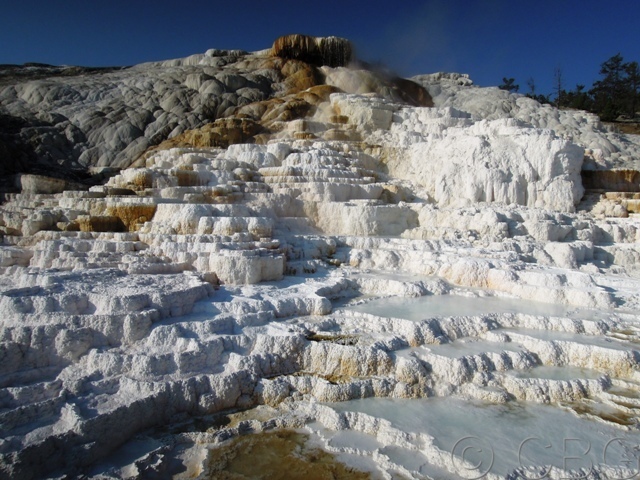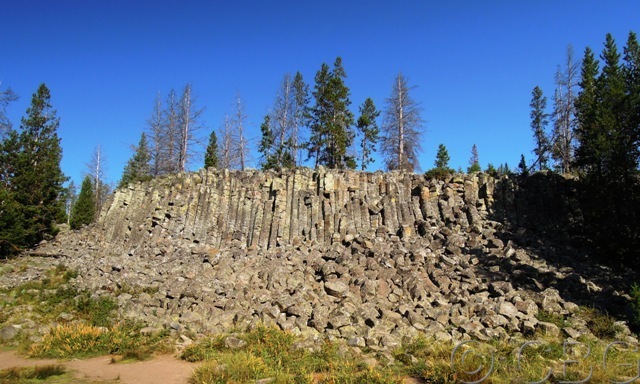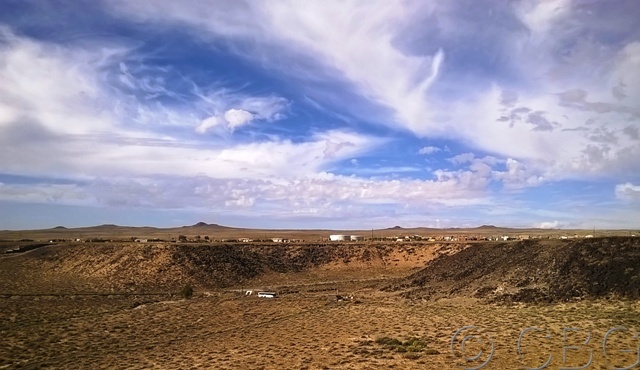Volcanic processes
Phenomena

Travertine hill (USA) – is formed on the spring of thermal water that flows through the limestone. Limestone rocks are source of calcium carbonate that is deposited after water cools on the surface. The orange colour is caused by the algae living in shallow pools on the terraces.

Basaltic lava flow (USA) - hexagonal columns with well defined joints are a result of slow cooling of the basalt lava flow. The cliff was exposed by the fluvial erosion of the nearby river.
Lava tube (USA) – Lava tube is a tunnel formed by the lava flowing beneath the hardened surface of a lava flow. The low-viscosity lava is drained and the walls and ceiling formed by the more viscous lava forms the tunnel-like feature.
Collapsed lava tube (USA) – when the ceiling of drained lava tube collapse, the canyon-like feature with steep walls and debris covered bottom is formed.
Pahoehoe lava (USA) - basaltic lava that has smooth, undulating or ropy surface. This lava is low-viscous.
Aa lava (USA) - lava with very rough and sharp surface composed of lava blocks. This lava is more viscous than the pahoehoe lava.

Inverted topography (USA) - the basaltic lava flow (dark coloured) originally flowed on the flat surface until it reached the hills and filled just the valleys on the piedmont. As the basalt is more resistant than the original hills (most probably sandstone), after long time the hills were eroded, and the basaltic lava flow now forms elevated surface.
Dike (Ponta de Sao Lourenço, Madeira) – Igneous dike is an elongated body of an igneous rock. It forms when molten rock intrudes in a fracture of a pre-existing rock body.
Volcanic bomb (Puy de la Vache, Massif Central, France) – Volcanic bomb is a pyroclast ejected from the volcanic vent during the eruption. It has an oval shape because it is shaped while in flight. Only pyroclastics larger than 64 mm in diameter can be called volcanic bombs.

Stratovolcano (Villarica, Chile) – Stratovolcano or composite cone is a conical volcano build up by alternating lava flows and unconsolided or consolided pyroclastics (tephra, pumice, volcanic ash). The sedimentation of layers of different volcanic rocks origins in periodic explosive and effusive eruptions. The overall composition of stratovolcanoes is andesitic. The classic stratovolcano shape is conical with gentle lower slopes and steep slopes near the summit.

Lahar (Chaitén volcano, Chile) – A type of mudflow or debris flow which is an accompanying process during the volcanic eruptions. It is composed of mixture of pyroclastic material, rock debris and water. Possible causes of lahars are melting of snow and glaciers during an eruption, mixture of lava flow with wet soil and mud, lake breakout during the eruption, heavy rainfall, volcanic landslides, or earthquakes.